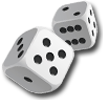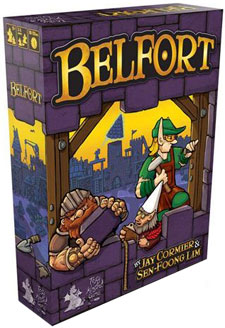



play board games
Board game reviews, strategy tips & session reports
Belfort Review
 Stats:
Stats:
No. of players: 2-5
Amount of time to play: 90-120 min
Age requirements: 13+
Set-up time: 5 – 10 minutes
The City is building a new castle called Belfort, but unfortunately officials hired too many supervisors. You are one of the supervisors trying to win the key to the City by out-building, and thus out-scoring, your opponents.
Belfort Rules Description:
Belfort is a worker placement strategy game with seven rounds. Three of the seven are scoring rounds.
After moving the round marker you place your workers. To start the game you have three elves and three dwarves. You will send them to recruit more elves or dwarves, change the turn order, gather resources or work in a guild. Some spaces are limited in number but the resource spaces are not. The thing is that certain spaces require a dwarf while others require an elf and one even requires both. The player with the most workers on a resource space gains one extra resource of that type.
Your workers can be upgraded to master workers. They work the same as normal workers, except they count as two workers.
Besides your workers and one of each resource type, you also start the game with three building cards. These cards represent the buildings you can make on your turn and require your resources to build. After constructing a building you can use its ability or possibly gain income from it. You can also build a wall or guild. When another player uses your guild you get paid by that player instead of the bank.
The map is divided into five areas. During scoring rounds each area scores based on the number of buildings each player has in it. After you pay the resources to build you get to place one of your houses on the map. Players with the most and second most buildings get points.
There are a couple other actions you can take besides building. You can visit the trading post to sell and buy resources, buy more building cards or hire a gnome. Gnomes are special workers that are needed to unlock some of the abilities on your finished building cards.
The second way you score is by having worker majority. You score for having the most and second most elves, dwarves or gnomes.
The seventh round is the third and final scoring round. Whoever has the most points is named the Master Architect and wins the game.
Quick Review of Belfort:
Belfort is a unique blend of worker placement with some area control. It is a fun strategy game with depth and lots of meaningful decisions. It has its intricacies but is a fairly straight-forward game to play.
The rulebook is funny, well-written and looks great. The components are high quality and the artwork is very nice.
I really like worker placement games and one of my favorite things about Belfort is the way it gracefully and effectively integrates area control. You need to pay attention to the map and remember that all your actions must help you when the scoring round comes.
I also like the way the rounds flow. Since you the Collection Phase comes before the Actions Phase. You can change the player order in the middle of the round and that really matters. Where you place for resources and the first player can greatly determine the actions available to you.
There is a reason Belfort was nominated for BGG Strategy Game of the Year. And though it didn’t win, it is still a very good game. If you enjoy worker placement games you’ll like this one. It is unique and fun, simple yet hard to master. Try it or just pick it up.
Score and synopsis: (Click here for an explanation of these review categories.)
Strategy 5 out of 6
Luck 4 out of 6
Player Interaction 4 out of 6
Replay Value 5 out of 6
Complexity 4 out of 6
Fun 5 out of 6
Overall 5 out of 6

While I only played this once, I enjoyed it and will play it again but didn’t love it right off the bat. I find that this would totally replace Lords of Waterdeep for me. It feels exactly like LoW with an area control game stuck in for scoring. It plays longer than LoW but has that extra bit of depth.
Yep, this takes what LoW does well and just adds another layer to it. LoW is great for introducing casual gamers and some non-gamers to worker placement games. Belfort is what they play after they are ready for the next challenge.